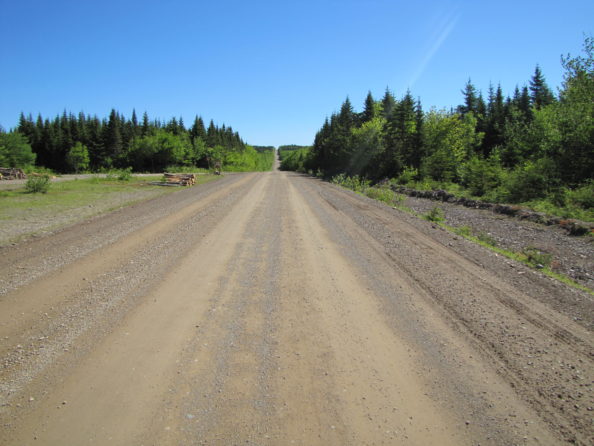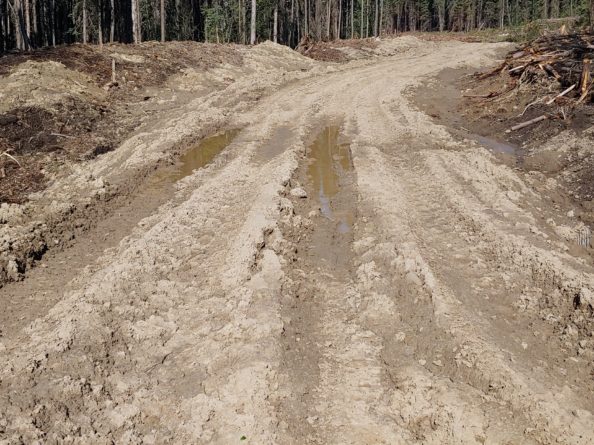It is undeniable that climate change has an impact on forest operations. Whether it is flash floods, droughts, warmer winters or strong winds, these events affect forest operations in different ways. They are problematic for the maintenance of access roads and transport, soil protection, fire prevention and recovery of wood after disturbance. FPInnovations researchers have taken a closer look at the impacts and are proposing adaptation measures which, for the most part, represent innovative solutions.

Maintaining access roads
Extreme precipitation and winter thaws have significant consequences on forest access, such as increased flows and debris at stream crossings and reduced ability to use winter roads. As the existing infrastructure was designed based on historical climate data, many of them will not be able to withstand the expected increase in the intensity and duration of precipitation.
An important first step is to assess the vulnerability of the road network[1]. This involves establishing the relationships between climate events and the existing infrastructure, that is, the probability that a certain climate event will occur and, if so, determining what will be the consequences for road infrastructure. Subsequently, adaptation measures, such as the replacement of a crossing or the improvement of road foundations, may become necessary; however, they will be expensive. Fortunately, in many cases, good practices to counter erosion and sedimentation (armouring, cleaning ditches or unblocking culverts) will be sufficient and inexpensive. An inventory of existing infrastructure (bridges, culverts, drains, signs, etc.) and updating their condition are essential. An asset management plan can significantly improve the resilience of a forest road network.

Timber transport
Winter and early spring thaws also cause access problems by rendering certain winter roads impassable, causing excessive sanding of the main roads and by imposing restrictions on transport schedules.
Fewer roads will be built on the assumption that transportation operations will take place in frozen ground conditions. Their construction and maintenance will have to be improved to ensure reliable transport throughout the year. A tire pressure monitoring system may be an option to prevent getting stuck in frequent thaw conditions. Changes in the practices and materials used for winter road design are to be expected, as well as in the abrasives used.
Case studies from British Columbia suggest that the spring load restriction period could occur up to 14 days earlier in the 2050s. If this prediction is correct, planning for transportation and harvesting operations will be considerably affected. It will be necessary to adapt our current planning, construction and maintenance practices.
Protection of soils and wetlands
During harvesting operations, soils with reduced bearing capacity are susceptible to the creation of ruts. In a context of heavy rainfall or winter thaw, this vulnerability increases and mitigation measures are necessary. With collaborators in the Abitibi region of Quebec, FPInnovations has developed a new management approach making it possible to choose the least expensive option to reduce the presence of ruts and their severity. Depending on the circumstances, the concentration of skidding (3 trails in 1) offers interesting alternatives. There are several ways to implement it. The innovative approach suggests that a decision be made by the management partners when the harvesters are assigned to the site.

Harvest after disturbance (fires, windfall, insect epidemics)
It is obvious that climate change will modify the behaviour and effects of natural disturbances: droughts increase the likelihood and severity of forest fires, the increase in temperatures favours insect epidemics and high winds cause more windfall.
In these cases, recovery of the affected trees must be implemented quickly before the wood degrades by focusing on preventive approaches such as those that have been tested in Western Canada and on Quebec’s North Shore.
The modernization of our operations must now incorporate adapted practices to promote the resilience of forest operations. Many of these practices are already known and considered best practices. In some cases, however, additional costs are expected. It is important to limit the impacts through proactive strategies essential to viable forestry operations.
For more information on the content of this article, please contact Mark Partington at mark.partington@fpinnovatins.ca or Philippe Meek at philippe.meek@fpinnovations.ca.
[1] Different protocols and frameworks are available for performing vulnerability assessments, but a common approach in Canada for assessing infrastructure risks is known as the PIEVC protocol (www.pievc.ca).